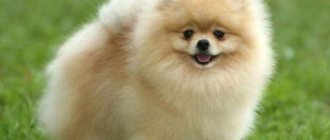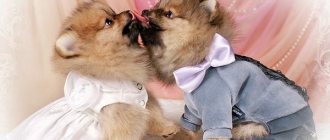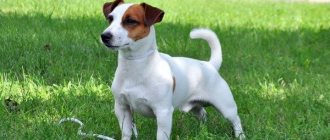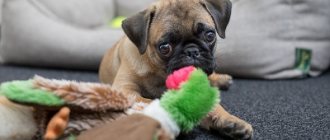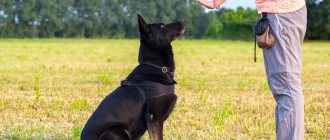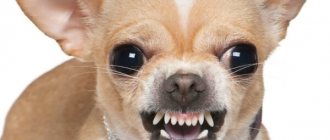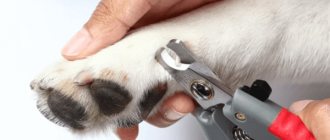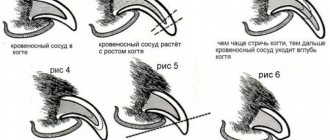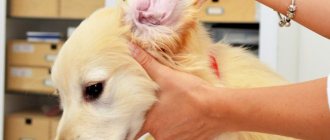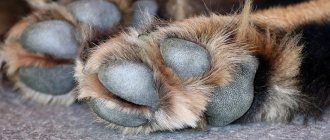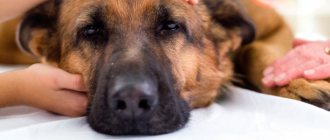Pugs are bred not only by professionals in specialized nurseries, but also by amateur breeders at home. To get healthy offspring with high breed characteristics, you need to take a responsible approach to choosing the most convenient and favorable time and partner for mating. When organizing the mating of pugs, you should adhere to the basic rules and advice of professionals, taking into account the nuances - the weight, height, age of the dogs, their physical and psychological readiness.
At what age can you breed a pug?
The first heat in female pugs occurs at the age of 7-10 months. Outwardly, during this period, dogs look like adults, but their bones and muscles are still underdeveloped. The puppies are not yet strong mentally, they do not always behave adequately, and their character cannot be called balanced. Mating pugs too early leads to unpleasant consequences:
- underdevelopment of muscles and bones;
- failure of the back line;
- psychological trauma for young individuals.
The physical development of pug cubs is completed by 1.5 years. RKF recommends mating males at 2 years of age, and females at 1.5-2 years, during the third heat. During this period, animals are at the peak of their physical fitness and can give birth to healthy offspring.
It should be taken into account that it is recommended to untie pugs before the age of 5; at an older age, the risk of complications during pregnancy and childbirth increases many times over.
- Manufacturers' choice
- Sexual cycles
- Caring for a pregnant dog
- Childbirth
- Caring for a whelping dog
- Complications during pregnancy and childbirth
- Raising and raising a puppy
- Puppy growth and development
- The puppy's place in the house
- Walking a puppy
- Puppy care
- Puppy care items
- Puppy food
6. Breeding pugs
Breeding pugs is one of the most difficult processes. The dog owner must be familiar not only with its physiology, but also with the basics of veterinary medicine.
In order to get a healthy litter, the dog owner needs to become familiar with the basic physiology of animal reproduction, study the basic rules for selecting sires, and some features of caring for a pregnant bitch and newborn puppies.
Manufacturers' choice
The correct choice of sires is of paramount importance to obtain a healthy litter that fully complies with the standard.
In this case, factors such as the general physical development of the dog, its constitution and breed characteristics should be taken into account. The timing of puberty in dogs primarily depends on the sex of the animal. For example, females are capable of breeding at the age of 6-8 months, and males - 12-16 months.
However, in order to obtain a viable, healthy litter, it is necessary to select individuals that have reached the general physical maturity of the body. Such animals should not be too young or very old. The reproductive capacity of female pugs is most developed at the age of 1.5–6 years, of male pugs – 2–7 years.
In order to obtain a litter that meets the standard, it is necessary to select the right sires. The dogs’ physical health, appearance, and type of behavior are important. You should not choose overly aggressive, easily excitable or cowardly dogs as breeders.
Sexual cycles
Bitches have sexual cycles twice a year. Males retain the ability to reproduce throughout the year. There are 3 phases of the reproductive cycle in females.
1st phase – precursor, or proestrum. The period lasts on average 5–8 days. At this time, the dog becomes restless, its appetite weakens, the mammary glands swell, the size of the external genital organs increases, and bloody discharge from the vagina is observed.
2nd phase – estrus, or estrus. The period lasts 6–10 days. During this time, dogs experience a strong sexual desire called heat. The amount of bloody discharge decreases somewhat and becomes transparent. During estrus, ovulation occurs and the eggs become capable of fertilization.
3rd phase – post-estrus, or metoestrum. The period lasts approximately 30–60 days. At this time, the dogs' sexual desire decreases sharply, after which it completely disappears. The discharge stops, the genitals acquire normal size.
It is recommended to breed dogs on the 9th–12th day of the reproductive cycle. After 1–2 days, mating should be repeated to ensure fertilization of the eggs.
Sexual intercourse in dogs lasts approximately 40–50 minutes. Animals should not be separated until it is completed.
If dogs show aggressiveness during mating, it is recommended to put muzzles on them.
Mating is recommended to be done in the morning, after a walk, before feeding the dog or 4-6 hours after that. Before mating, animals should be given the opportunity to get comfortable in an unfamiliar environment and sniff each other. Usually they bring a bitch to a dog.
It is not recommended to breed a bitch more than once a year, since more frequent matings can lead to exhaustion of her body and the birth of inferior, weakened offspring.
Males at the age of 2–3 years are often used for mating 6–8 times a year, at the age of 3–8 years – 20–30 times.
Fertilization occurs when sperm and egg fuse. Pregnancy in dogs is multiple and lasts approximately 62 days. Signs of pregnancy usually appear at 2 months. At the same time, the dog’s body weight and the volume of its abdomen increase, its appetite increases, and the animal’s behavior changes.
Carefully palpating the bitch's abdomen will help determine the approximate number of embryos.
Caring for a pregnant dog
During the puppy period, the dog needs to be carefully cared for. Particular attention is paid to the animal’s diet. For normal pregnancy and proper development of embryos, the bitch should be provided with a balanced diet, giving her high-quality, easily digestible food containing large amounts of proteins, minerals and vitamins. You can add bone meal, fish oil, fresh vegetables and fruits, as well as vitamin preparations to your food.
During this period, the amount of food is increased by giving the dog meat and dairy products.
However, we should not forget that overfeeding, as well as lack of food, has a negative effect on pregnancy. It is recommended to feed the puppy 3 times a day. A pregnant dog needs special care.
Throughout pregnancy, the dog should be walked daily for at least 2 hours.
This is necessary to supply the animal’s body with oxygen, improve metabolism and strengthen muscles. In the second half of pregnancy, the dog should not be allowed to make sudden movements.
Before giving birth, it is recommended to prepare in advance replacement bedding, sterile gauze wipes, hot water, scissors and boiled linen threads.
Childbirth
Proper care during pregnancy ensures that the dog’s birth proceeds without complications and often does not require human intervention.
The owner must first prepare the place where the dog is to whelp. For this purpose, it is recommended to set aside a secluded, dimly lit corner where the animal will not be disturbed. The floor mat must be clean.
2-3 days before the expected birth, colostrum begins to be released from the bitch’s nipples. At the same time, the animal’s body temperature decreases by 1–2 °C.
Many experts believe that animals should not be allowed to eat all the afterbirth, as this often causes digestive upset.
In order to most accurately determine the due date, it is necessary to regularly measure the dog’s body temperature in the last days of pregnancy. Just before giving birth, the animal refuses food and becomes restless.
The onset of contractions, indicating contraction of the muscles of the uterus, cause painful sensations, causing the dog to whine, periodically change body position and move from one place to another.
Contractions are initially short, with an interval of 15–30 minutes. Then they become longer, breaks are reduced to 2–5 minutes.
The process of dilating the cervix takes an average of 3–8 hours. After the membranes rupture, contractions begin to alternate with pushing, which is a contraction of the abdominal muscles.
The duration of the birth process depends on the number of puppies in the litter and averages 10–24 hours. Puppies appear at different intervals. During prolonged labor, it is recommended to take the dog out for a short walk, giving it the opportunity to empty its bladder and bowels. In addition, physical activity stimulates labor.
After the birth of the next puppy, the dog bites the umbilical cord, chews and then eats the fetal membrane, licks the newborns, pushing them towards the nipples.
Usually the placenta comes out immediately after the birth of the puppy, and sometimes 2-3 hours after the end of labor. If after this time the placenta has not come out, it is necessary to give the dog an injection of a drug (after consulting with a veterinarian) that causes uterine contractions.
We should not forget that delayed placenta often leads to the development of various inflammatory processes.
If after the birth of the puppy the dog has not chewed the fetal membrane, you need to carefully cut it, then tear it apart with your hands and tie the umbilical cord in two places at a distance of 2 and 6 cm from the abdominal wall of the puppy.
After this, the umbilical cord is cut with scissors between the dressings and the wound is treated with iodine. Then the puppy's body is thoroughly wiped with a clean napkin.
After giving birth, it is not recommended to disturb the dog or handle newborn puppies for 24 hours. If a dog has a developed maternal instinct, it can take care of its offspring on its own.
Caring for a whelping dog
After giving birth, the dog must be protected from physical activity. It is necessary to halve the duration of walking (especially in cold weather), and also take appropriate preventive measures to prevent the occurrence of various diseases.
In the area reserved for dogs and newborn puppies, the bedding should be changed regularly to avoid contamination.
It is advisable to select a large and comfortable box for dogs and puppies.
Place for dogs and puppies
It is recommended to wipe the dog’s genitals and mammary glands 2 times a day with a cotton swab dipped in a weak solution of potassium permanganate.
For 1–2 weeks after birth, the dog experiences mucous discharge from the vagina. Grayish and then colorless discharge is considered normal. If they acquire an unpleasant odor and a dark green color, you should immediately contact your veterinarian.
When a dog is feeding puppies, it is necessary to increase the amount of food given to the dog. The diet should contain meat, milk and vitamin supplements.
If the dog does not lactate or refuses to feed the puppies, the owner needs to take care of feeding them. For artificial feeding, cow's milk or infant formula is used, heated to a temperature of 38–39 °C. Puppies are fed from a bottle with a nipple.
Mother's milk contains all the nutritional elements necessary for newborn puppies and therefore plays an important role in their development.
Complications during pregnancy and childbirth
Often, pregnancy and then the birth of dogs are accompanied by various complications caused mainly by metabolic disorders, pathology of internal organs or improper care of the animal.
False pregnancy occurs after mating of dogs in the absence of fertilization. Its symptoms are in many ways similar to the signs of real pregnancy and manifest themselves in the animal’s excited state, an enlarged abdomen, and the appearance of milk.
A sick dog should be taken to a veterinarian immediately. In addition, milk and all dairy products must be excluded from her diet.
Often the early stages of pregnancy in a dog are accompanied by toxicosis, the main symptoms of which are depression, general weakness, decreased appetite and vomiting. In this case, adjustments must be made to the animal’s diet.
A consequence of improper feeding of the dog during pregnancy, as well as insufficient physical activity, is swelling, which usually forms around the mammary glands and on the hind legs.
With this complication, it is recommended to halve the amount of liquid in the dog’s diet, do not overfeed it, regularly walk it and massage the swollen area.
In some cases, dogs experience a weakening of labor. This is often caused by a large or multiple pregnancy or the weakened physical condition of the animal. The process of fetal birth is delayed due to weak contractions of the uterine muscles.
In case of such complications, you should call a veterinarian, before whose arrival you need to provide first aid to the dog: give the animal warm milk or water and give a light abdominal massage.
It should be borne in mind that the use of stimulant drugs can cause irreparable harm to the dog’s body. Therefore, it is not recommended to use them without the knowledge of a specialist.
Incorrect position of the fetus complicates the process of its removal. In this case, you need to help the dog by carefully pulling the puppy by the emerging parts of the body - the head or hind limbs. It is recommended to discuss this situation with your veterinarian first.
We should not forget that various complications during pregnancy can affect the health of newborn puppies. To prevent this from happening, the dog owner must follow the rules for keeping a dog. If any illness occurs, you should immediately contact a veterinarian.
You should immediately contact a specialist if:
– absence of signs of labor after the due date;
– contractions and attempts not accompanied by the appearance of the fetus;
– fetus getting stuck in the birth canal;
– the appearance of stillborn cubs;
– weakening or cessation of labor if the fetus remains in the uterus;
– retention of the placenta after the birth of all puppies.
Raising and raising a puppy
Taking care of raising and raising a puppy, the owner must monitor its growth and development, feed and care for it accordingly. Only in this case will the pet grow up healthy, full of strength and energy.
Puppy growth and development
Development is a complex process in which, along with an increase in the animal’s body weight, the exterior, character corresponding to a specific breed, and physiological characteristics of the body develop and change.
Knowledge of the basic patterns of dog growth and development is necessary for the proper raising of a puppy.
The growth and development of a puppy is divided into several stages, characterized by their own characteristics.
Knowledge of the rate and duration of growth, as well as the nature of changes in the proportions of the animal’s body at each stage of its development is necessary for the proper raising of the pet. Pug puppies grow very quickly.
The stages of dog growth and development are divided into: intrauterine (embryonic), suckling (from birth to 1–1.5 months), puppy (1.5–6 months). They are further divided into young animals (6–12 months) and young dogs (from 12 months to 2.5 years).
The uterine and suckling periods are characterized by a rapid growth rate. At the same time, the foundations of the animal’s health are laid.
Puppies are weaned from the bitch at 30 days of age. At this time, dogs, as a rule, pass into the hands of their new owners, and a new stage begins in the life of the animals. Feeding with mother's milk and communication with other puppies from the litter stops.
At this time, the growth rate of puppies slows down sharply. However, with proper feeding and proper care, the weight of animals during the 2nd month of life increases approximately 2 times.
It is the responsibility of each owner to monitor the puppies' weight gain daily. Once they are 3 weeks old, they need to be weighed weekly.
Proper feeding and appropriate maintenance during the period from 6 to 8 months are decisive when raising animals.
Subsequent stages of growth and development of puppies can be divided into the following periods: from 2 to 6 months, the dog’s weight increases by 2 times, the height at the withers increases by 2–3 times: from 6 to 12 months, the puppy’s weight increases by only 25–30%, height at the withers - by 10%. The process of forming the exterior continues for 2–2.5 years.
The growth of puppies is uneven. At each stage, only certain organs and parts of the body develop intensively. Proportions appropriate to the breed appear only after all stages of the dog’s development have been completed.
The main indicator of proper growth and development of puppies is the replacement of baby teeth with permanent ones. At the age of 1 month, the puppy should have canines, incisors, 1st and 2nd false molars. All baby teeth appear at 2 months.
At 3 months, the dog’s central incisor teeth change. In the period from 3 to 5 months, the middle incisors change; in 4–6 months, the outer incisors, called edges, change.
At the age of 4 to 5 months, the canines change, and at 5–6 months, false teeth change. At 7 months, molars grow in.
Thus, at 7 months the dog has all 42 permanent teeth. A lag in the process of replacement and growth of teeth, their weakness and fragility indicate improper development of the animal, the cause of which is the insufficient content of vitamins A and D and mineral salts in food.
In order to monitor the puppy’s growth process, it is recommended to adhere to the following weighing schedule: at the age of 1-2 months - every 5 days, 2-6 months - every 10 days, then monthly.
The height at the withers is measured with a square and tape, the circumference of the chest and metacarpus, as well as the height of the leg at the elbow - with a measuring tape. When measuring the height at the withers, you need to ensure that the puppy stands with his head raised and the position of his paws is correct.
The chest circumference is measured behind the shoulder blades, the metacarpus - just below the wrist joint. At the same time, pull the measuring tape tightly. It should be borne in mind that measurement and weighing are carried out at the same time - before feeding.
The puppy's place in the house
Choosing a place for a puppy usually depends on living conditions.
However, in any case, he should not be allowed to live on the aisle, where he will disturb all family members, or near the door, from under which the air will blow on him. The puppy must have its own place.
Do not place the puppy in the bathroom, in a room with a tiled or cement floor, or near heating appliances. A rug is placed in the place chosen in the house for the puppy. Cotton bedding and mattresses should not be used as they are unhygienic. You can make a rectangular frame from slats, stretch a tarp over them, attach it to the frame, and put a rug on top. If necessary, the tarpaulin is removed and washed.
Walking a puppy
In order for the puppy to grow and develop properly, it needs to be walked. After each feeding, as well as after sleep, the puppy should be taken out into the yard and given the opportunity to run, since physical exercise is one of the important elements of the proper raising and maintenance of a dog of any breed.
Playing with peers contributes to the correct physical development of the puppy. At the same time, the owner needs to be sure that the other puppy is healthy.
However, we should not forget that a puppy overtired from games will not be able to eat normally. He may begin to vomit and have an upset stomach. You should not overwork your puppy or require him to perform a physically impossible task. Games and walks in the fresh air should be regular and, most importantly, feasible.
During walks, you must ensure that the puppy does not pick up food from the ground.
Puppy care
Puppies are born deaf and blind. They begin to see sight on the 10th–15th day, and after a few days they begin to hear. The first person a puppy should see when it first opens its eyes is its owner.
Despite the fact that the pet recognizes its owner by touch, it has yet to associate its tactile sensations with the owner’s smell and speech. This is facilitated by the puppy’s developing sense of smell and hearing. Communication with the owner allows the puppy to form its first opinion about people in general. A breeder needs to spend a few minutes a day with each pet. This is necessary so that from the first days of their life the animals get used to the owner. From the moment puppies are born until they are purchased by breeders, dogs continue to adapt to the world around them. From about 3 weeks of age, animals begin to recognize people. At this moment, it is necessary to give each puppy maximum attention. At the same time, you can pick them up, caress them, and talk to them. Starting from 4 weeks of age, you need to take the puppies out of the box every day for 10 minutes a day, weaning them from their mother and littermates.
The time of separation must be gradually increased.
In addition, you need to accustom puppies to other inhabitants of the house, guests and friends. The puppy should not be allowed to show aggression towards them. The slightest attempt to rush, for example, at a cat should be stopped immediately. When accustoming a puppy to people who often visit the house, you need to make sure that they do not feed the pet, do not frighten it, and especially do not punish it. You need to gradually accustom puppies to people
. In addition to group games, you should not forget that you also need to play with each puppy separately, since this is what contributes to the emergence of a trusting attitude towards people.
From birth to 16 weeks of age, every puppy goes through certain critical periods of development. If, for example, at the age of 3–7 weeks the pet was not given enough attention, it will not be able to realize all its potential.
Small pets should be accustomed to various household sounds. For example, before putting food in a bowl, you need to tap it with a spoon.
There are several rules for caring for puppies, the implementation of which is necessary for pets to grow up healthy, full of strength and energy.
One of the main indicators of a dog's health is the animal's good sleep. Healthy newborn puppies spend 90% of their time sleeping and 10% eating. During sleep, puppies are active: they slightly twitch their limbs and smack their lips.
Another sign of a puppy's good health is its ability to quickly find its mother's nipple and suckle vigorously.
From the moment the puppy's claws curl, they begin to be trimmed. Otherwise, the puppy may scratch the mother when massaging her breast while sucking milk. Scratches often lead to mastitis.
Starting from 2 weeks of age, the procedure for trimming the puppy’s nails should become regular and should be carried out approximately once every 7–10 days.
The puppy must be regularly brushed and wiped with a damp cloth along the coat.
Wash the puppy only when necessary. When washing, you need to make sure that water does not get into your ears. After bathing, the puppy must be dried and protected from drafts. The puppy's area must be kept clean.
Puppy care items.
There are a number of items needed to care for your puppy. These include a harness and a soft collar. The harness, made of soft material, does not interfere with the puppy while moving and does not injure him. The collar is worn so that two fingers can easily fit under it.
To brush your dog, you need a soft brush, preferably a massage brush, rubber or nylon.
In addition, the puppy needs toys. They are given to the dog so that it does not spoil things and furniture. It is not recommended to use household items as toys, since the puppy, having gotten used to playing, for example, with old slippers, will then take new ones.
You can hang various toys and balls on a rope or elastic band.
Puppy food
Often in multiple litters, some of the puppies are weak or underdeveloped. The reason for this is that the bitch does not always have enough milk for all the cubs. The dog owner must take care of such puppies.
In order not to exhaust the bitch, it is necessary to feed the poorly developing puppies from the litter. Monitoring the growth and development of suckling puppies is carried out by determining their weight, which must certainly increase daily.
Currently, there are a variety of foods available for sale for puppies of small breeds of dogs of different ages. Complementary feeding should be introduced from 3 weeks of age.
As complementary foods, you can use warm milk with the addition of sweet tea and raw eggs. In the first days, puppies are fed 0.25 glasses of milk per day using a nipple. By the age of one month, the dose is increased.
When accustoming your puppy to feeding, you need to lightly push him towards the bowl with the mixture. He will lick his lips first and then perhaps start lapping. At the age of 3–4 weeks, puppies are given complementary foods 2 times a day, 4–5 weeks – 3 times, 5–7 weeks – 4 times.
Some dog breeders feed their puppies raw minced meat. However, this is not suitable food for them, since it does not cause active work of the stomach and intestines and is not completely absorbed.
At the age of 4–5 weeks, the puppies are transferred to dry food; at the age of 5–6 weeks, they are gradually taken away from their mother, leaving her with her only at night.
So, gradually the puppies stop needing mother's milk and learn to accept solid food.
Starting from the 5th week, puppies begin to be fed milk semolina porridge, and from the 6th week - oatmeal soup cooked in meat broth. The meat must be chopped.
After 6 weeks from birth, puppies begin to add vegetables to their food. You can give them finely chopped raw meat, fish fillet, cottage cheese, yogurt, raw eggs, grated carrots.
Dog breeders recommend using fish oil as a vitamin supplement. You should start with 3-5 drops daily. At the age of 3 months, puppies can be given 2-3 teaspoons of fish oil and 1-2 pinches of chopped fresh herbs. If a puppy has an upset stomach, fish oil is excluded from the diet.
Calcium glycerophosphate can be given to puppies as a mineral supplement.
In the first 3 months of the animal’s life, feeding is given at 0.5 tablets; at 7–8 months of age, the dose of calcium glycerophosphate in the puppy’s diet should be increased to 5 tablets. The amount of food for a puppy depends on its age
. In addition, finely chopped nettles and scalded with boiling water, raw beet and carrot tops or cabbage leaves can be added to the puppy's food.
The daily intake of vitamins A and D per puppy is approximately 2 to 10 drops. The absence or deficiency of nutrients in an animal’s body often causes growth retardation and various deviations from normal development. Experts also recommend placing chalk or charcoal near the puppy’s bowl.
Many dog breeders are of the opinion that puppies should be fed a variety of foods. It must be taken into account that the boiled food should not be very liquid or thick, it should not contain hot seasonings and spices. You should not give pets food that is frozen and then thawed.
It should be borne in mind that the amount of food given to each individual puppy directly depends on its age and appetite and usually varies.
If there is food left in the bowl after feeding, reduce the next portion of food. If after feeding the puppy does not leave the bowl for a long time, the amount of food needs to be increased.
There are several basic rules that must be followed when feeding a puppy:
– you should not feed the puppy by hand or spoon, as in the future the dog will refuse to eat from the bowl;
– the puppy must know its place in the house. You should not give him food at the table during lunch and in the kitchen at the moment when they are cooking;
– if a dog refuses the food offered to it, it is not recommended to replace it with another type of food, since the animal, having learned that it can get something more tasty, will subsequently refuse regular foods;
– You should not force-feed your dog if it refuses food. The reasons for this are often poor quality food or the presence of some disease in the puppy;
– You should not teach your puppy to catch thrown food in the air. Food must be placed in a bowl. In this case, it is necessary that the dog does not pick up anything that falls on the floor.
Table of contents
How to choose a mate for your dog?
The selection of pugs for mating is approached responsibly. The quality of future pugs depends on the health and genetic characteristics of the partners. In order to identify the shortcomings and defects of parents in a timely manner, they participate in exhibitions and competitions, and listen to the assessment of experts. Breeding puppies with a good pedigree are one of the conditions for a successful choice. When determining a partner for a pet, you should cull the animals:
- not meeting the standard;
- with serious genetic diseases or anatomical defects;
- those who are overweight, have problems with the functioning of the cardiovascular system;
- too small or too large;
- who have undergone major surgery.
Even if a pug has one of these shortcomings, you should not breed with it. When choosing a male dog, pay attention to his temperament, which determines his activity during mating.
Signs of readiness
In this situation, it is necessary to monitor the behavior of the bitch.
A signal of its readiness is the animal’s close interest in nearby males, impulses to escape from its owners, restlessness and playfulness, as well as frequent urination.
From the moment the estrus begins, it is better not to let the animal go outside without a leash, in order to prevent any accidental mating with a non-pedigreed male.
On what day of heat are pugs bred?
The ideal time to mate pugs is considered to be the tenth to fourteenth days of estrus. Since each pug’s body is individual, the timing may shift in both directions. It is more reliable to focus on the course of heat, the behavior of the bitch and changes in her physical condition. In the next 2-3 days, pugs appear, if at the sight of a male dog the bitch does not growl, flirts with him, arches her back, moves her tail, does not obey the owner, the loop apparently enlarges, softens and the blood discharge changes to lighter.
Pros and cons of the breed
The advantages of the breed include:
- bright and unusual appearance;
- compact size;
- devotion to the owner;
- ease of care;
- love for children;
- friendly character;
- unpretentiousness in food;
- intelligence and intelligence.
Like representatives of other breeds, pugs also have a number of disadvantages.:
- poor health – sensitivity to high and low air temperatures and difficulties with the respiratory system;
- the need for regular and careful care of the folds on the face;
- high fatigue;
- inability to be alone due to excessive attachment to the owner;
- snoring that occurs due to the structure of the nasopharynx;
- tendency to gain excess weight;
- allergic reactions;
- molt.
How long does a female dog go into heat?
To correctly determine when to breed a pug, owners of high-breed dogs should keep a diary and record the timing and duration of estrus. This will help not only not to miss the period when pugs can mate, but also to prepare special hygiene products, transfer the bitches to a new place, and isolate them from other animals. Hunting in females occurs twice a year and lasts from 20 to 25 days. The duration of estrus is accurately determined experimentally, noting its beginning and end in a diary.
Education and training
The very first thing you should teach your pet is its name.
Pugs are smart and quick-witted, but stubborn and may simply not want to follow commands, so when training the dog, the owner must show patience and leadership qualities.
It is necessary to start classes as early as possible, starting with a set of basic commands like “sit” and “no”.
You should also accustom your pet to a bed (the “place” command), otherwise the dog will sleep in the owner’s bed.
To train, you need to develop a system and carry it out regularly twice a day. The owner must behave persistently, but patiently and gently, not show aggression and not physically punish the pet.
For all achievements and completed commands, the pug must be encouraged and praised . This way he will have the incentive and desire to continue learning.
In addition to learning commands, the pug needs to be accustomed to a harness, leash and muzzle.
For what reason does pugs not get pregnant after mating?
Breeding dogs is not as easy as it might seem at first glance. Even if the terms and rules of mating are observed, sometimes female pugs do not become pregnant. The reason may be:
- too young or advanced age of individuals;
- incorrect timing for mating;
- pathologies, infections, hormonal imbalance in the bitch;
- male sterility;
- too frequent matings of the male, after which the sperm does not have time to mature.
What to do if it doesn't work out
First of all, you don’t need to get upset and under no circumstances scold the dog. In animals, like humans, the fertilization process is not always successful and this is normal.
It is important to soberly assess the situation, analyze the entire mating period, the mistakes made and try to prevent them next time.
But you shouldn’t discount the rather sad option of infertility of your dog or its partner, the cause of which could be congenital pathologies of the internal genital organs, acquired diseases, or even psychological problems.
Breeding pugs at home: instructions
If a dog breeder does not have experience in mating representatives of famous breeds, it is better to invite a dog trainer. If this is not possible, follow the following diagram:
- Before mating, walk the dogs and do not feed them.
- Mating should be carried out in the yard or indoors.
- Let the pugs in and let them sniff each other.
- Monitor the behavior of pets, preventing possible aggression in time.
- Leave the couple alone for a while.
- Record the act of mating.
If there is insufficient experience of individuals, mating is carried out manually:
- The owner of the bitch holds her by the collar and under the belly.
- The owner of the dog guides the dog.
- After ejaculation, the pets are placed in a “corner” or with their backs to each other.
Pugs can stay in the “castle” from several minutes to an hour. During this period, they do not need to be disturbed, much less taken away.
Origin story
There is no single version regarding the origin of pugs, but most scientists believe that they descended from the “Lo Jie” dogs, which resemble Pekingese in appearance, and their homeland is the People’s Republic of China.
The first mentions of this breed were found in Chinese manuscripts dating back to 600 BC.
In Europe, the first representatives of the breed were registered at the end of the 16th century. Pugs were popular among representatives of high society, and the presence of such a pet spoke of the good tone and taste of the owner.
The first club for pug lovers was opened in 1883 in England, the first official standard was adopted in 1888.
In Russia, they learned about this breed only at the end of the 19th century, but due to wars and revolutions it was on the verge of extinction, appearing again only in the 80s of the 20th century.
Which pug girl is suitable for breeding?
The bitch is untied until she is four to five years old. After seven they are most often not used for breeding. Normally, a female pug will have up to six litters in her lifetime. Mating during the next heat after pregnancy is not advisable. The dog’s body does not have time to recover during this time. If at least six months have passed since the birth of the puppies, the female feels well, and the previous pregnancy passed without complications, it is permissible to carry out two matings in a row.
Before breeding pugs, they should be treated for worms and fleas. The veterinary passport must contain vaccination records. In order not to reduce the likelihood of conception, the bitch should be healthy and not overweight at the time of mating.
Is mating necessary?
Many people who are far from cynology believe that a bitch must give birth at least once, and a male dog must be “introduced” to a girl at least once. Otherwise, they say, the dog will feel deprived and may even get sick.
In fact, animals do not feel the need to mate. In a wild environment, in packs of predatory canines, not all males have offspring, but only those who have proven their strength, endurance and perseverance by defeating many rivals in battle for a female.
And the same she-wolves do not all give birth to wolf cubs, since they also have their own hierarchy and lower-ranking females are not allowed to breed. At the same time, none of the “childless” animals feel deprived in any way and, even more so, do not get sick due to the lack of sex life.
People, having taken upon themselves the functions of creators of factory breeds, including pugs, often abuse this and use animals in breeding that can do nothing to improve the gene pool of future generations, and sometimes only spoil it.
Important! Only pugs that have high show scores and come from healthy lines should be used for breeding.
Mating, especially early, will not bring anything good to a non-breeding dog and its offspring. A male dog, after going for a walk once, will begin to knit everything in a row, and a bitch who has given birth only once may later develop a pronounced false pregnancy.
Puppies that do not have documents of origin will cost much less and, as a result, you will have to spend much more money on raising them than you can get from selling them. At the same time, no one can guarantee that a puppy purchased inexpensively will be in good conditions and will live a long and happy life in a loving family.
Therefore, dogs should be bred only if they are excellent in appearance, are not carriers of hereditary diseases, and can improve the gene pool.
How to untie a male pug?
Each owner of a purebred pug must decide for himself whether he will untie it or not. If the choice remains with the first option, then the owner will have to regularly handle the pet throughout its life. Males for mating must be of breeding class, with excellent pedigree, absolutely healthy, without hereditary diseases, with high marks for exterior. Early mating leads to a stop in growth and development, so it is more correct to breed a pug for the first time at the age of 2 years.
Immediately before the procedure, the dog needs to be walked, after which he is introduced to the girl. The day before and after mating, the dog’s organs are washed and treated with Miramistin.
Pet character
Pugs are companion dogs that want to be close to their owner anywhere and everywhere and participate in all aspects of his life.
They are friendly and cheerful dogs with a calm and cheerful character..
No cynologist or any amount of training can turn a pug into a watchdog - there is no aggression in representatives of this breed, they love everyone and are happy to see everyone.
They do not strive to dominate, so they easily get along with other pets, especially their own kind.
CAREFULLY!
It is not advisable to keep large dogs with a pug, as they can accidentally damage their eyes during play.
These dogs love to be in society, to be close to the owner and his family, and are completely unsuited to loneliness; they literally suffer when left alone.
Pugs are the kindest, most positive and loving dogs I know..
It is impossible to be sad with them, the dog is always there and will always try to cheer you up. These dogs love children very much and quickly find a common language with them.
They need to immediately show who is boss, otherwise there will be problems during training: they are smart, but stubborn and can completely refuse to follow commands.
How to mate dogs for the first time?
It happens that during the first mating, pugs get scared, not understanding what is required of them. A young male may refuse to approach a bitch, so an experienced male should be selected for her. At the end of the process, when the dogs are separated, they are taken to different rooms and given water. If partners are left together, they may mate again. Too frequent matings exhaust the dog and take away his strength, so a control mating is carried out the next day.
Basic rules for breeding pugs
To successfully breed pugs, they adhere to several rules:
- Mating is arranged on the territory of the male dog so that he feels confident.
- For young, inexperienced females, experienced sires are selected.
- It is more convenient to pair on a table or other elevated surface, covering the surface with a non-slip rubber mat.
- After several matings, the male is allowed to rest by transferring him to another room.
- Before mating, potential parents of pugs are tested for bacteria and checked for infection.
- Animals are dewormed 3-4 times a year and vaccinated according to the vaccination calendar.
Preparation stages
In the case of female pugs, great attention is paid to the preparation stage for mating.
The preparatory stage consists of several steps . Checking the dog's health 3 months before the upcoming mating. This step is necessary to ensure that the pregnancy passes without any complications and that a miscarriage does not occur.
As part of this step, appropriate tests are taken to identify the infection.
Then, a month before the expected pregnancy, it is necessary for the bitch to lose excess weight. In addition, it is necessary to remove worms from the animal if there are any, get rid of fleas, and get the necessary vaccinations.
The owners of the male dog must also be notified of the expected date of crossing..
The course of pregnancy in a bitch
It is difficult to understand that a bitch is pregnant in the first month after mating. This is done based on indirect signs - the dog is less active, sleeps a lot, although the appetite remains the same.
Pregnancy lasts 63-64 days. In its second half, characteristic symptoms appear:
- loop gluing;
- colorless discharge;
- swelling of the mammary glands;
- dramatic fluctuations in appetite - from complete refusal of food to begging for an additional portion;
- toxicosis.
On the fortieth day after mating, an ultrasound is performed to determine the presence of pregnancy and the number of fetuses.
What to do after
Within a month after mating, you can determine whether the dog is pregnant or not. Her behavior changes, the female becomes lethargic, begins to sleep and eat more, gains weight, and there is a rare urge to urinate.
According to these signs, offspring are expected in 2 months, but to find out for sure, you should contact a veterinary clinic (the visit is scheduled for 6-7 weeks after mating). There the dog will undergo an ultrasound and will be provided with all the necessary recommendations for pregnancy management.
Labor activity in pugs
The approach of childbirth is judged not only by approximate dates, but also by a number of signs:
- the dog searching for a “nest”;
- loss of appetite and refusal to eat;
- drooping belly;
- decrease in body temperature to 37 ⁰C;
- heavy breathing.
If all signs appear, labor is expected no later than 6-7 hours later.
A spacious, comfortable box is pre-installed for the dog, the bottom of which is covered with foam rubber, a blanket and disposable diapers. A separate box is prepared for puppies, where a heating pad is placed. You will need cotton swabs, brilliant green and containers of boiled water.
Prenatal contractions last 12-24 hours, after which pushing begins, lasting about 20 hours if the birth is the first. Most often, dogs cope on their own, but the presence of the owner nearby is necessary for the pet. When difficulties arise with birth, you should urgently call a veterinarian.
Brief comparison with other similar breeds
Pugs also have some similarities with Pekingese, mainly regarding character, origin and behavior.:
- both breeds originate from China;
- both have a shortened muzzle;
- cannot tolerate long separation from the owner;
- equally capable of training;
- prone to similar diseases related to the respiratory system and eye problems.
But most often, despite the rather extravagant appearance of pugs, they are often confused with French bulldogs.
Both breeds have a compact size and a square body format, however, bulldogs have erect, rounded ears, a curved tail and powerful jaws.
Bulldogs are also more active and playful.
Read more about which dog breeds are similar to the pug here.
Are they suitable for an apartment and good with children?
Pugs are compact dogs with fairly low activity levels, so they don't require much space..
In addition, they simply cannot be kept in an enclosure due to their sensitivity to air temperature - they are susceptible to hypothermia and overheating.
All this makes these dogs ideal pets for apartment living..
Read about other features of keeping pugs here.
Representatives of this breed get along well with children.
They are not at all aggressive and at the same time inquisitive, so they happily spend time with children and play with them, becoming their best friends.
